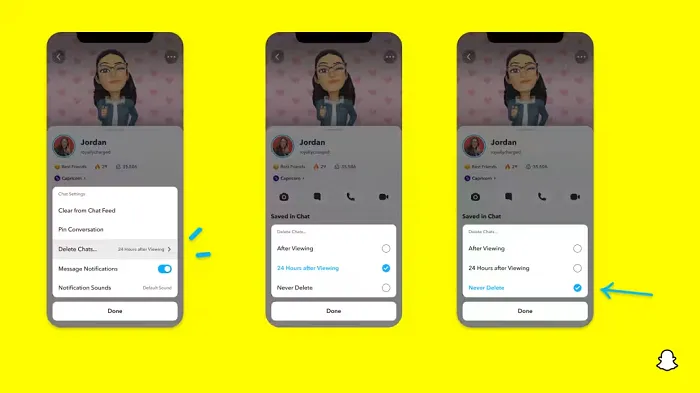SOCIAL
Snapchat Outlines its Approach to Misinformation and How it’s Seeing Success in Combating its Spread


Snapchat has published a new overview of its ongoing efforts to combat the spread of misinformation in its app, which also provides some valuable insights into the variance between Snap and other platforms, and why it requires a unique, dedicated approach.
While Facebook and Twitter work to contain false information, particularly around vaccine side effects amid the COVID-19 pandemic, Snapchat has largely remained out of the discussion around the same, with its alternative approach to social potentially outlining a framework to better manage news distribution in this respect.
Essentially, Snapchat says that it’s ultimately seeing success with its approach to misinformation and safety due to the app’s design, which is focused on maintaining close connections, as opposed to broadcasting to the general public.
As explained by Snap:
“Snapchat was originally built to help people talk to their close friends, rather than provide the opportunity to broadcast messages across the app. And we have always felt a deep responsibility to make sure that the news and information our community sees on Snapchat is credible, from trusted and clear sources.”
Indeed, the more enclosed nature of the app does afford it some benefits in this regard, while as noted, that also provides an interesting point as to why Snapchat marketing is different.
“Across our app, we don’t allow unvetted content the opportunity to ‘go viral.’ Snapchat does not offer an unmoderated open newsfeed where unvetted individuals or publishers can broadcast false information.”
The public news feed approach, which seeks to amplify content that generates the most engagement, really incentivizes the ‘hot take’ approach to press coverage, where balance and reason are less likely to spark interest than sensationalism and partisan reporting.
This has been underlined many times – a study conducted by MIT in 2018 found that false news stories are a full 70% more likely to be retweeted than true reports, while Twitter’s retweet chains of false reports “reach a cascade depth of 10 about 20 times faster than facts”. Another study published last year found Facebook to be driving significant traffic to untrustworthy news sources.
And it makes sense. Hollywood gossip magazines have fashioned an entire industry around longbow reporting, even blatantly false stories, because it’s far more interesting to share something controversial, something that goes against the grain, which is more exciting than people’s everyday lives. Part of us, inherently, wants to be the one in the know, the one who gets told the big secrets before everybody else, the behind the scenes info and chatter. And no doubt, and can be a thrill to share the latest rumors with your followers, and get all the Likes and comments as a result.
That makes sense, but when you expand that same framework to political news and health information, as we’ve seen more recently, that can have significant, dangerous consequences.
These days, however, everyone is their own media outlet, sharing and re-sharing the latest things ‘they don’t want us to know’. People can now curate their very own gossip magazines, on any issue that they like, and in many ways, it’s human nature to seek out these edge examples in a bid to crack the unknown codes of the world, and feel part of something bigger. That, in a broader sense, is a major issue in the social media landscape, and giving every person a platform to amplify such, because people want the notification rush, the pings of excitement that come with those red alerts in their apps.
Snapchat eschews this by deliberately not providing a public news feed, which lessens the incentive to be controversial, and to fish for likes and comments with these hot takes.
That’s really the biggest reason why Snapchat has been able to avoid much of the associated controversy, though it also notes that it takes additional, defined steps to prohibit the spread of identified misinformation, fact check all political and advocacy ads (by human review), and impose limits on the size of group chats to further reduce potential amplification.
There’s even a specific dig at Facebook’s approach to the same:
“Our approach to enforcing against content that includes false information is straightforward – we don’t label it, we completely remove it.”
In some ways, Snap can be seen as a model for moderation in these respects, but as Snap itself points out, it’s not the same as Facebook, Twitter or Instagram, in that public comments and discussion are not readily available, and have less opportunity to gain viral traction.
So while Snap is patting itself on the back here, it’s also clearly pointing out that it’s not the same as other social apps, so there’s not really a direct comparison.
Could other apps have approached things in a less public manner? I mean, Facebook kind of does, in that your main News Feed, where people spend most of their time, is populated by people who you’re connected to. But because everybody is on Facebook, that still gives it an expanded scope for amplification – if Snapchat had the same amount of users as Facebook does, it would likely be in a similar situation.
But maybe, removing public posting as an option could be a way to reduce the spread of such in all apps? Maybe that could lessen the incentive to post engagement bait, as a means to ‘go viral’ and get those Likes.
Maybe.
It’s hard to say, but it could be something worth considering – but then again, neither Facebook nor Twitter is likely to do that, given the engagement benefits they see from public posting in their apps.
So it’s not the same, it’s not a real comparison here. But it’s interesting to consider Snapchat as a case study on such either way.
SOCIAL
Snapchat Explores New Messaging Retention Feature: A Game-Changer or Risky Move?

In a recent announcement, Snapchat revealed a groundbreaking update that challenges its traditional design ethos. The platform is experimenting with an option that allows users to defy the 24-hour auto-delete rule, a feature synonymous with Snapchat’s ephemeral messaging model.
The proposed change aims to introduce a “Never delete” option in messaging retention settings, aligning Snapchat more closely with conventional messaging apps. While this move may blur Snapchat’s distinctive selling point, Snap appears convinced of its necessity.
According to Snap, the decision stems from user feedback and a commitment to innovation based on user needs. The company aims to provide greater flexibility and control over conversations, catering to the preferences of its community.
Currently undergoing trials in select markets, the new feature empowers users to adjust retention settings on a conversation-by-conversation basis. Flexibility remains paramount, with participants able to modify settings within chats and receive in-chat notifications to ensure transparency.
Snapchat underscores that the default auto-delete feature will persist, reinforcing its design philosophy centered on ephemerality. However, with the app gaining traction as a primary messaging platform, the option offers users a means to preserve longer chat histories.
The update marks a pivotal moment for Snapchat, renowned for its disappearing message premise, especially popular among younger demographics. Retaining this focus has been pivotal to Snapchat’s identity, but the shift suggests a broader strategy aimed at diversifying its user base.
This strategy may appeal particularly to older demographics, potentially extending Snapchat’s relevance as users age. By emulating features of conventional messaging platforms, Snapchat seeks to enhance its appeal and broaden its reach.
Yet, the introduction of message retention poses questions about Snapchat’s uniqueness. While addressing user demands, the risk of diluting Snapchat’s distinctiveness looms large.
As Snapchat ventures into uncharted territory, the outcome of this experiment remains uncertain. Will message retention propel Snapchat to new heights, or will it compromise the platform’s uniqueness?
Only time will tell.
SOCIAL
Catering to specific audience boosts your business, says accountant turned coach

While it is tempting to try to appeal to a broad audience, the founder of alcohol-free coaching service Just the Tonic, Sandra Parker, believes the best thing you can do for your business is focus on your niche. Here’s how she did just that.
When running a business, reaching out to as many clients as possible can be tempting. But it also risks making your marketing “too generic,” warns Sandra Parker, the founder of Just The Tonic Coaching.
“From the very start of my business, I knew exactly who I could help and who I couldn’t,” Parker told My Biggest Lessons.
Parker struggled with alcohol dependence as a young professional. Today, her business targets high-achieving individuals who face challenges similar to those she had early in her career.
“I understand their frustrations, I understand their fears, and I understand their coping mechanisms and the stories they’re telling themselves,” Parker said. “Because of that, I’m able to market very effectively, to speak in a language that they understand, and am able to reach them.”Â
“I believe that it’s really important that you know exactly who your customer or your client is, and you target them, and you resist the temptation to make your marketing too generic to try and reach everyone,” she explained.
“If you speak specifically to your target clients, you will reach them, and I believe that’s the way that you’re going to be more successful.
Watch the video for more of Sandra Parker’s biggest lessons.
SOCIAL
Instagram Tests Live-Stream Games to Enhance Engagement

Instagram’s testing out some new options to help spice up your live-streams in the app, with some live broadcasters now able to select a game that they can play with viewers in-stream.
As you can see in these example screens, posted by Ahmed Ghanem, some creators now have the option to play either “This or That”, a question and answer prompt that you can share with your viewers, or “Trivia”, to generate more engagement within your IG live-streams.
That could be a simple way to spark more conversation and interaction, which could then lead into further engagement opportunities from your live audience.
Meta’s been exploring more ways to make live-streaming a bigger consideration for IG creators, with a view to live-streams potentially catching on with more users.
That includes the gradual expansion of its “Stars” live-stream donation program, giving more creators in more regions a means to accept donations from live-stream viewers, while back in December, Instagram also added some new options to make it easier to go live using third-party tools via desktop PCs.
Live streaming has been a major shift in China, where shopping live-streams, in particular, have led to massive opportunities for streaming platforms. They haven’t caught on in the same way in Western regions, but as TikTok and YouTube look to push live-stream adoption, there is still a chance that they will become a much bigger element in future.
Which is why IG is also trying to stay in touch, and add more ways for its creators to engage via streams. Live-stream games is another element within this, which could make this a better community-building, and potentially sales-driving option.
We’ve asked Instagram for more information on this test, and we’ll update this post if/when we hear back.
-

 PPC5 days ago
PPC5 days ago19 Best SEO Tools in 2024 (For Every Use Case)
-

 MARKETING7 days ago
MARKETING7 days agoStreamlining Processes for Increased Efficiency and Results
-

 PPC7 days ago
PPC7 days ago97 Marvelous May Content Ideas for Blog Posts, Videos, & More
-
SEARCHENGINES7 days ago
Daily Search Forum Recap: April 17, 2024
-

 SEO7 days ago
SEO7 days agoAn In-Depth Guide And Best Practices For Mobile SEO
-
SEARCHENGINES6 days ago
Daily Search Forum Recap: April 18, 2024
-

 MARKETING6 days ago
MARKETING6 days agoEcommerce evolution: Blurring the lines between B2B and B2C
-
SEARCHENGINES4 days ago
Daily Search Forum Recap: April 19, 2024



